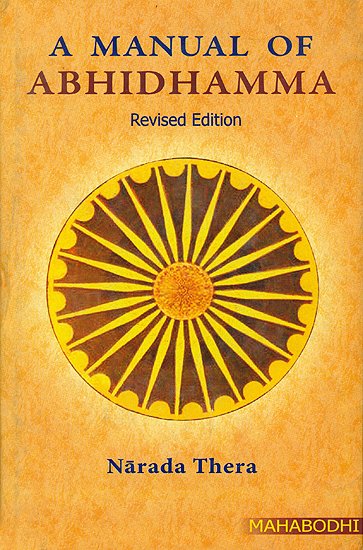A Manual of Abhidhamma
by Nārada Thera | 80,494 words | ISBN-13: 9789380336510
In the Abhidhammattha Sangaha there is a brief exposition of the Law of Dependent Origination, followed by a descriptive account of the Causal Relations that finds no parallel in any other philosophy. Edited in the original Pali Text with English Translation and Explanatory Notes by Narada Maha Thera....
Different Combinations of Mental States
§ 3
Tesam cittāviyuttānam[1] - yathāyogamito param
Cittuppādesu[2] paccekam - sampayogo pavuccati
Satta sabbattha yujjanti - Yathāyogam pakinnakā
Cuddasā'kusalesv'eva - sobhanesv'eva sobhanā.
§ 4. Katham?
Sabbacitta-sādhāranā tāva satta cetasikā sabbesu'pi ek'ūnanavuti-cittuppādesu labbhanti.
Pakinnakesu pana:-
- Vitakko tāva dvipañcaviññāna vajjitakāmāvacaracittesu c'eva ekādasasu pathamajjhānacittesu cā'ti pañcapaññāsacittesu uppajjati.
- Vicāro pana tesu c'eva ekādasasu dutiyajjhānacittesu c'āti chasatthi cittesu jāyati.
- Adhimokkho dvipañcaviññānavicikicchāvajjita-cittesu .
- Viriyam pañcadvārāvajjana-dvipañcaviññana-sampaticchana-santīrana-vajjitacittesu.
- Pīti domanass'upekkhāsahagata-kāyaviññānacatutthajjhāna-vajjitacittesu.
- Chando ahetuka-momūhavajjitacittesu labbhati.
§ 5.
Te pana cittuppāda yathākkamam: -
Chasatthi pañcapaññāsa-ekādasa ca solasa
Sattati vīsati c'eva - pakinnakavivajjitā
Pañcapaññāsa chasatthitthasattati tisattati
Ekapaññāsa c' ekūna - sattati sapakinnakā.
(translation)
§ 3.
The combination of each of these thought-adjuncts in different types of consciousness will hereafter be dealt with accordingly.
Seven are linked with every type of consciousness. The (six) Particulars are linked accordingly. The fourteen are linked only with the Immorals, the (nineteen) Beautiful, only with the Beautiful.
§ 4. In what way ?
In the first place, the seven mental states common to every consciousness are found in all the eighty-nine types of consciousness.
Among the "Particular" mental states:-
-
"Initial Application"[3] arises in fifty-five types of consciousness, to wit;
i. In all types of kāmāvacara consciousness, excluding the twice fivefold sense-consciousness. (54 - 10 = 44).
ii. Also in the eleven types of first Jhāna consciousness. (44 + 11 = 55) - "Sustained Application" arises in sixty-six types of consciousness, to wit: In those fifty-five and in the eleven types of second Jhāna consciousness. (55 + 11 = 66).
- "Decision" arises in all types of consciousness, excluding the twice fivefold sense-consciousness and consciousness, accompanied by "Doubt". (89 - 11 = 78).
- "Effort" arises in all types of consciousness, excluding the sense-door directing consciousness, twice fivefold sense-consciousness, receiving consciousness, and investigating consciousness. (89 - 11 = 73).
-
"Joy'' arises in all types of consciousness, excluding those accompanied by displeasure, and indifference (equanimity), body-consciousness,* and the fourth Jhāna consciousness. (121 - (2 + 55 + 2 + 11) = 51).
*[Body-consciousness - viz., that which is accompanied by pain and that by bliss (dukkha and sukha)] - "Conation" arises in all types of consciousness, excluding the ahetukas and the two modes of consciousness accompanied by delusion. (89 - 20 = 69).
§ 5.
Those types of consciousness in order are:
Sixty-six, fifty-five, eleven, sixteen, seventy, and twenty without the Particulars.
Fifty-five, sixty-six, seventy-eight, seventy-three, fifty-one, sixty-nine are with the Particulars.[4]
Footnotes and references:
[1]:
[ cittāviyutta - Lit., inseparable from consciousness, i.e., Cetasikas-mental states]
[2]:
[ cittuppādo - Lit., genesis of consciousness. Here the compound term applies to consciousness alone; in other cases both to consciousness and its adjuncts]
[3]:
[ vitakka does not by nature occur in the ten types of moral and immoral resultant sense-consciousness. It has been eliminated in the Higher Jhānas by means of concentration]
[4]:
[ At the end of the section the definite number of cittas in which the Particulars are not found and found is given. It should be noted that some numbers refer to the total of 121, and some to 89]
